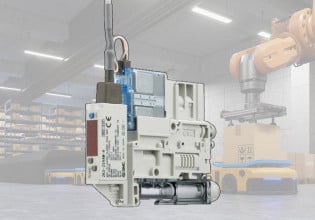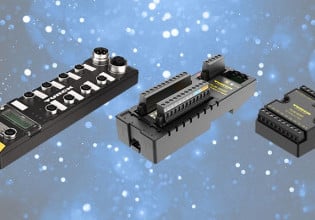Mechanisms Used in Robotic Compliance Devices
Compliance and compensator devices are used in processes where variation and uncertainty are prevalent. What sorts of compliance devices are used, and what distinct advantages are held by each?
When engineers and plant managers think of precision placement of components, they likely imagine a robot over manual labor. Workers are often inconsistent in their placement; check any fast food burger and you’ll find the various components stacked a little differently each time. Furthermore, some of these repetitive assembly, picking, packaging, and some machining operations lead to an increased probability of injured workers. These are best left to a machine.
So then, how does one train a robot to precisely position components during these operations? This is the purpose of a compliance device. Compliance devices are often placed between the robotic arm and the gripper or machine tool to help adjust for minor misalignments.
Figure 1. Force compliance devices find use in tasks that are subject to frequent misalignments and inconsistencies.
It is important to note that misalignments are not just a result of inconsistencies in designed processes, but can stem from uncontrolled variables as well. Consider a robot that is performing a picking operation of randomly-oriented components from a bin. Those components may shift right as the robot accelerates and begins moving to the pick point, leading to misalignments from a machine vision system’s image to the reality of picking up the product. Thermal expansion of components may lead to misalignment as well, which means machine dimensions during startup may be different than the dimensions during regular use.
Types of Compliance Devices
There are several common kinetic and feedback methods of compliance devices currently on the market. Depending on the robotic system and the specific application, some compliance devices may be more appropriate than others. Also, some of these systems can be combined to form hybrid systems, with the most common hybrid model being electronic sensors in a feedback loop to move mechanical, pneumatic, or hydraulic actuators.
Mechanical Compliance Devices
Mechanical compliance devices are perhaps the simplest and most widespread. The easiest compliance devices include tapered pins, chamfered edges, and other mechanisms that will cause mating surfaces to want to fit together. The use of polymers as gripping surfaces and in between contact points also help push parts to their required location, just like the human hand manipulates an object, instead of relying directly on contact with bone.

Figure 2. Mechanical force compliance with springs providing force. This model also has a pneumatic cylinder to return the plate to the center position. Image used courtesy of ATI Industrial Automation
More complicated mechanical compliance devices involve spring-loaded systems that can trigger additional force to bump a robotic gripper a little closer to where it needs to be. Others have flexible spring surfaces that apply more or less force depending on the position of the part along its surface.
The key feature with mechanical compliance devices is that they must be able to reset to their original shape. Springs, tension bars, soft robotics, and so on must only deform in the elastic region, else they will need to be replaced. Furthermore, the contacts between these surfaces must remain clean, as a speck of dust will change the delivered force to the component.
Pneumatic/Hydraulic Compliance Devices
Some compliance devices are pneumatic, in that compressed air is used to apply the proper pressure across the robotic arm. Pneumatic systems require a supply airline, so these are particularly convenient for manufacturing environments where electricity is limited or mechanical devices are susceptible to dirt or grime.

Figure 3. A pneumatic force compliance tool specifically designed for deburring. Image used courtesy of RAD Robotic & Automation Solutions
Hydraulic compliance devices also exist and serve the same purpose and behave in a similar manner to pneumatic ones. The choice between pneumatic and hydraulic can be determined by the specific needs of the facility. Often, there is compressed air available, making pneumatic devices common, though hydraulic systems can typically apply larger pressure. Furthermore, tapping into the in-house compressed air may not be desirable, as small robotic components will require cleaner air than many other pneumatic tools.
Electrical Compliance Devices
Perhaps the most complicated compliance devices are electrical. These systems rely on precise feedback from a network of pressure and position sensors (optical, ultrasonic, etc) to determine where the object is located relative to its desired position. Based on the difference between these two points, the error signal is generated, and actuators move robotic parts for perfect alignment.
Electrical systems are also commonly integrated with others, often pneumatic or hydraulic, sending the error signal to valves and pumps to control the pressure on the grip and more precisely position the components. These hybrid systems may be the most complex, but are also very common.
Figure 4. Electric force compliance models are some of the most complex but versatile tools for the task.
Industrial Applications
Compliance devices are commonly used in picking and packing operations, where precise gripping must be used to select and place products. In picking operations, robots may need to place products into jigs, rails, pins, and other mounts for future processing steps. If they are misaligned, workpieces and machinery can be damaged. In the worst case, a misalignment may damage both the workpiece and the robot or assembly line. With a compliance device, small misalignments can be corrected, reducing the odds of damage.
More recently, compliance devices have been used in machining operations. Grinding, polishing, and other finishing steps can be performed with robotic tools. The advantages are twofold. First, the finishing steps can be performed in a more consistent, repeatable manner. Second, manual grinding operations are notorious for causing worker injuries. Numerous repetitive motion injuries, such as Hand-Arm Vibration Syndrome (HAVS), high-speed particles, fume inhalation, and other potential hazards can be avoided with the help of automation.
For finishing operations, compliance devices can ensure proper pressure is applied to grinding media. The applied pressure means each workpiece will be ground evenly, but it also means that cutting disks, sanding belts, and other equipment will have longer, more predictable lives. Ultimately, this means a more repeatable, consistent finish, higher throughput, and fewer rework or scrap situations.
Force Compliance and Compensation
Overall, the use of a compliance device can remove some of the problems caused by misalignment errors. These errors can lead to damaged equipment, increased rework and scrap, and other such problems. Furthermore, the use of compliance devices increases the repeatability of operations so that the final product is more consistent.
The cost of adding compliance devices should be weighed against the cost of misalignment errors. For some products and small part counts, minor misalignment may not be worth the investment. However, as smarter compliance devices are developed, more applications will benefit from this investment.






